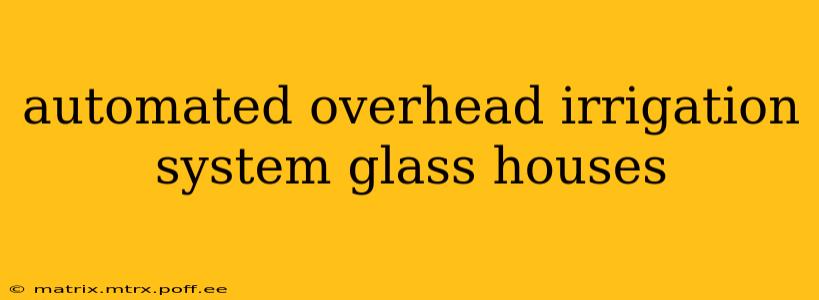The efficiency and productivity of a glasshouse operation heavily rely on precise environmental control, and irrigation plays a vital role. Automated overhead irrigation systems are becoming increasingly popular in modern glasshouses due to their ability to deliver water precisely and efficiently, optimizing plant growth and minimizing water waste. This guide will delve into the specifics of these systems, addressing common questions and providing insights for growers aiming to improve their operations.
What are the benefits of automated overhead irrigation in glasshouses?
Automated overhead irrigation systems offer several advantages over manual irrigation methods. These include:
- Improved Water Use Efficiency: Precise control minimizes water waste by delivering only the necessary amount of water directly to the plants. This is especially crucial in regions with water scarcity.
- Enhanced Labor Efficiency: Automation eliminates the time-consuming task of manual watering, freeing up labor for other essential tasks within the glasshouse.
- Consistent Water Delivery: Automated systems provide consistent watering, preventing fluctuations in soil moisture that can negatively impact plant health and yield.
- Optimized Fertilizer Application: Many systems allow for the simultaneous application of fertilizers, reducing labor and improving nutrient uptake efficiency.
- Disease Prevention: Consistent moisture levels can reduce the risk of plant diseases that thrive in overly wet or dry conditions.
- Improved Crop Quality: Consistent and precise watering leads to healthier plants, resulting in higher quality yields.
What are the different types of automated overhead irrigation systems used in glasshouses?
Several types of automated overhead irrigation systems cater to the diverse needs of glasshouse operations:
- Drip Irrigation: While technically not overhead, drip systems are highly efficient within glasshouses, delivering water directly to the plant's root zone, minimizing evaporation and runoff. It's often used in conjunction with overhead systems for supplementary watering.
- Sprinkler Irrigation: This classic overhead method uses sprinklers to distribute water across the growing area. Different nozzle types provide varying spray patterns, allowing customization based on plant needs and spacing.
- Micro-sprinkler Irrigation: This system utilizes smaller sprinklers delivering water more gently and precisely than larger sprinklers. It’s ideal for delicate plants or seedlings.
- Rain Bird Irrigation Systems: A widely recognized brand known for its reliable and technologically advanced irrigation components, often integrated into automated glasshouse systems. (Note: No direct links provided as requested.)
How do I choose the right automated overhead irrigation system for my glasshouse?
Selecting the appropriate system involves considering various factors:
- Crop type and spacing: Different plants have varying water requirements, influencing the choice of irrigation method and nozzle type.
- Glasshouse size and layout: The dimensions of the glasshouse and the arrangement of plants will dictate the number of sprinklers or emitters needed.
- Water availability and quality: The water source's capacity and quality will influence system design and the potential need for filtration or treatment.
- Budget: Automated systems vary significantly in price, and careful consideration is necessary to balance cost and functionality.
- Climate: The local climate influences the frequency and duration of irrigation.
What are the costs associated with automated overhead irrigation systems for glasshouses?
The cost of an automated overhead irrigation system can vary considerably, depending on factors like the size of the glasshouse, the complexity of the system, and the components selected. Initial investment costs include equipment (pumps, controllers, pipes, sprinklers, filters), installation labor, and any necessary modifications to the glasshouse structure. Ongoing costs encompass maintenance, repairs, and water usage.
How do I maintain an automated overhead irrigation system in a glasshouse?
Regular maintenance is crucial to ensure the system's longevity and efficient operation. This includes:
- Regular inspections: Checking for leaks, clogs, and damaged components.
- Cleaning: Cleaning filters and nozzles to prevent blockages.
- Calibration: Regularly checking and adjusting the system's settings to ensure optimal water distribution.
- Repair and replacement: Promptly addressing any issues to prevent further damage.
By carefully considering these factors and implementing a well-maintained automated overhead irrigation system, glasshouse operators can significantly enhance their productivity, efficiency, and profitability while promoting sustainable water management practices. Remember to consult with irrigation specialists to tailor a system specific to your unique needs.
